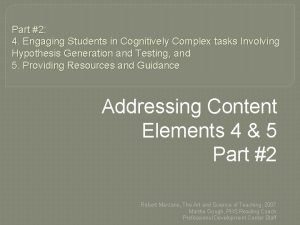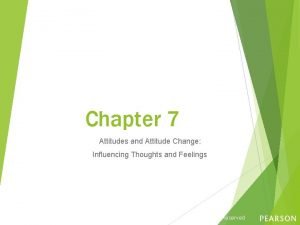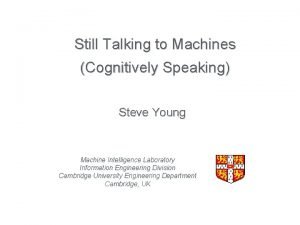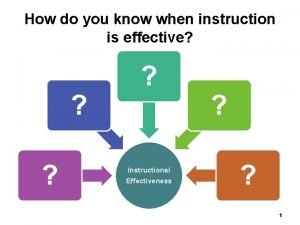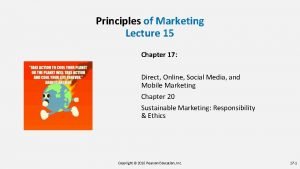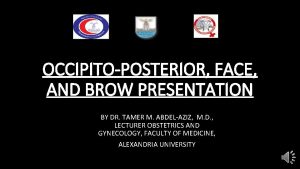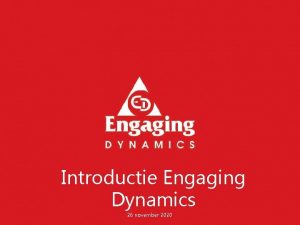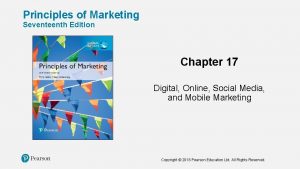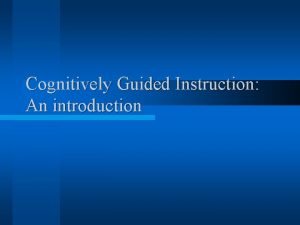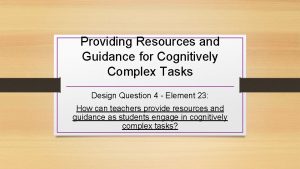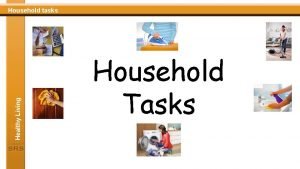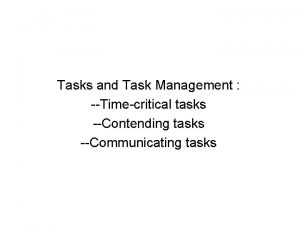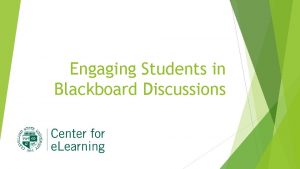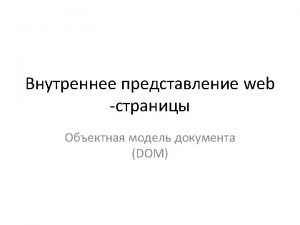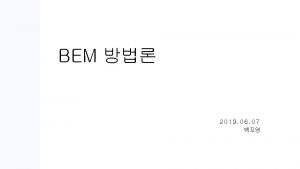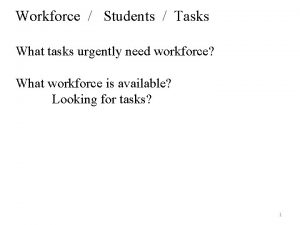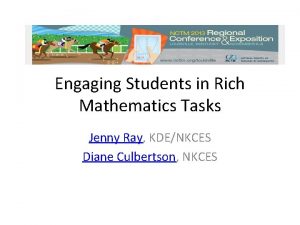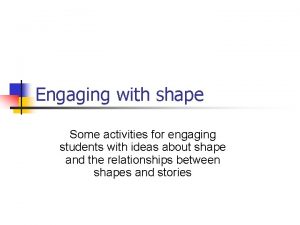Focus Element Engaging Students in Cognitively Complex Tasks




















- Slides: 20

Focus Element Engaging Students in Cognitively Complex Tasks Involving Hypothesis Generation and Testing Design Question 4 – Element 22

Focus Elements Arizona College and Career Ready Standards requires more clarity in the progressions of knowledge being addressed in class, more application of knowledge by students along with more and deeper inferential thinking, and the creation of sound evidence for conclusions and claims. Seven elements are instrumental to these ends. The teachers should disclose a clear sequence or progression of facts, details, and lowerorder skills to more robust generalizations, principles, and processes. At the end of a lesson, students should be able to describe how the details of the lesson build to support bigger ideas and processes. Element 22, engaging students in cognitively complex tasks involving hypothesis generation and testing, might be considered the “centerpiece” strategy of a CCSS classroom. Students are constantly asked to make predictions and provide support for the logic of their predictions. Additionally, they are provided opportunities (some brief and some extended) to test out the efficacy of their predictions. http: //www. marzanocenter. com/files/Robert_Marzano_Common_Core_handout_20130604. p

Engaging Students in Cognitively Complex Tasks How will you engage students in short and long term complex tasks that require them to generate and test hypothesis and analyze their own thinking?

In DQ 2, students acquire new knowledge but have not stored their new knowledge in long-term memory. In DQ 3, students practice and deepen understanding of the new knowledge. In DQ 4, students apply this knowledge so that it becomes embedded into long-term memory.

This Element is Applicable to ALL Classrooms!! • When most teachers see that Design Question 4 mentions hypotheses, they automatically believe that the element only pertains to science curriculum but that is NOT true. • Hypothesis generation includes: • Investigating • Decision Making • Problem Solving • Experimental Inquiry • Inventing • Student-design tasks The possibilities are endless! For more ideas about how to incorporate hypotheses in your classroom, click here. Update links in All About Marzano using examples from book

Before we begin… Before we begin talking about element 22, let’s be sure that there is an understanding about how the elements in Design Question 4 are related. This is important as you plan your lessons. While watching the video, please take notes, documenting how the elements in Design Question 4 are related.

How do the Elements in DQ 4 related to each other? Introduction to Design Question 4 DSBPC Pro Development. "Introduction to Design Question 4: (Helping Students Generate and Test Hypotheses). " You. Tube, 06 Mar. 2014. Web. 10 Mar. 2016.

How are the elements related to each other? • You should have noticed: • Element 21 outlines how students should be organized within cooperative learning groups for the purpose of engaging in cognitively complex tasks. • Element 22 demonstrates that the teacher should provide students with cognitively complex tasks that allow them to generate and test hypotheses about open-ended questions with multiple correct responses. • Element 23 shows that while teachers are a coach or guide on the side during this process, they still have a responsibility to provide resources and support as students work through the process. Now let’s talk about element 22, specifically.

Review Teacher and Student Evidence NOTE: This list of evidence is not all inclusive but is instead a list of possible examples.

Review Scale for Element 22

Desired Effect for Student Learning Strategies will only produce desired effect when implemented accurately and in the right context. The desired effect for element 22 is “Students generate and test hypotheses to enhance their understanding of content and the inquiry process. ” To receive an Innovating rating, the teacher must adapt and create new strategies for unique student needs and situations in order for the desired effect to be evident in ALL students.

Before watching the videos, think about… • How do you engage your students in cognitively complex tasks? • Cognitively complex tasks include: • Answering more “how” and “why” questions; less memorized questions that can be answered by Google. • • • Thinking critically and solve problems. Analyzing data and discussing what can be learned from results. Applying knowledge. Making inferences and supporting reasoning. Making conclusions and claims supported by evidence. Evaluating the validity and accuracy of an author’s thinking & beliefs.

Example of Element 22: Engaging Students in Cognitively Complex Tasks Involving Hypothesis Generation and Testing • Element 22 Engaging Students in Cognitively Complex Tasks • Note: This video provides three different examples of element 22. The beginning of the video up to the 2: 50 mark provides an overview of the element. • To view an example of this element in a high school classroom begin watching the video at the 2: 51 mark. • To view an example of this element in a middle school classroom begin watching the video at the 5: 40 mark. • To view an example of this element in an elementary school classroom begin watching the video at the 7: 10 mark. DSBPC Pro Development. "Element 22 Engaging Students in Cognitively Complex Tasks. " You. Tube, 14 Mar. 2014. Web. 10 Mar. 2016.

Examples of Element 22: Engaging Students in Cognitively Complex Tasks Beginning Developing Applying Innovating

Example of Element 22: Engaging Students in Cognitively Complex Tasks Involving Hypothesis Generation and Testing • Generating & Testing Hypotheses Elementary Ways 2 learn. "Generating & Testing Hypotheses Elementary. " You. Tube, 02 Oct. 2012. Web. 10 Mar 2016.

Now that you have watched the videos, reflect… • In addition to engaging students in cognitively complex tasks involving hypothesis, and to achieve an Applying rating, how can you monitor the extent to which students are generating and testing hypotheses? Need monitoring ideas? Click here • To achieve an Innovating rating, how will you adapt and create new strategies for engaging students in cognitively complex tasks involving generating and testing hypotheses that addresses ALL unique students and situations? Need adaptation ideas? Click here

Remember… • When planning lessons, look for topics that allow for extended comparisons. • Model how to create and use comparisons, classifications, similes, metaphors, and analogies. • Ask students to explain and justify their reasoning. • Ask students to revise their comparisons and classifications after discussing them with peers. Login. " Login. N. p. , n. d. Web. 27 June 2016.

It’s Your Evaluation, Make the Most of It! Your evaluator will only rate you on what he/she sees which is OK because it is not necessary for you to have everything checked in the teacher and/or student evidence to receive a good rating. Also, remember you can invite your evaluator to your classroom to see you using this element. You have control of what your evaluator sees.

Is This Element in Your PGP? 1. Sign into www. effectiveeducators. com. 1. Click on the Growth tab 2. Click on the Plans option. 3. Open your current plan and fill out a new Reflection Log, answering the appropriate questions. 2. Decide how you will change your teaching as a result of viewing this module. 3. Execute your change, reflect on its impact, and complete another Reflection Log in i. Observation.

How Are You Supported? Here are resources in case you have further questions: • • Your evaluator Another evaluator on your campus Your school’s Classroom Practice Mentors (CPMs) For more examples and resources visit the All About Marzano website • Everything you ever wanted to know (and more) about Engaging Students in Cognitively Complex Tasks - Pasco County Schools
 Cognitively complex
Cognitively complex Cognitively guided instruction
Cognitively guided instruction Cognitively demanding
Cognitively demanding Central and peripheral routes to persuasion
Central and peripheral routes to persuasion Types of attitudes
Types of attitudes Disadvantages of cognitively guided instruction
Disadvantages of cognitively guided instruction Cognitively speaking
Cognitively speaking Instructional effectiveness
Instructional effectiveness Marketing involve engaging directly with carefully targeted
Marketing involve engaging directly with carefully targeted Fundal grip
Fundal grip Engaging dynamics
Engaging dynamics Marketing involve engaging directly with carefully targeted
Marketing involve engaging directly with carefully targeted Prolepsis
Prolepsis Porter competitive strategy
Porter competitive strategy Actor focus vs object focus
Actor focus vs object focus Cost focus and differentiation focus
Cost focus and differentiation focus Why rizal called champion of filipino youth
Why rizal called champion of filipino youth Quiz on simple compound and complex sentences
Quiz on simple compound and complex sentences The electra complex
The electra complex Simple compound complex and compound-complex sentences quiz
Simple compound complex and compound-complex sentences quiz Psychodynamic personality theory
Psychodynamic personality theory
